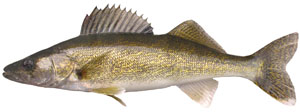Walleye
Latin Name
Sander vitreus
Group Name
Freshwater
Habitat
The natural distribution of walleye are the Arctic river basins from Labrador to the Mackenzie River drainage in the Northwest Territories, the St. Lawrence River drainage including the Great Lakes and the Mississippi River basin south to Alabama. Walleye have been introduced elsewhere in North America and in particular are now invading the Canadian portions of the Columbia River drainage. Walleye are large predators adapted to low light and are found in large, shallow turbid lakes and the deeper waters of clear lakes. Walleye form a dominant part of the fish fauna of central Canada, particularly in the boreal forest zone.
Species Description
Walleye are perciform or perch-like fish. A characteristic of these fish is a dorsal fin (the fin on the top or back of the fish) that is divided into two parts. The anterior or front part is spiny and the posterior or rear part is soft. Walleye have a dark green back, golden yellow sides and a white belly. In French, the common name is doré, which means golden. In English Canada, walleye are commonly called yellow pickerel or simply pickerel. Walleye can easily be confused with their close relative the sauger. Only walleye have a white margin on the lower lobe of the caudal (tail) fin and only sauger have several rows of black dots on their dorsal fin.
Why the unusual name? The eyes of walleye are like those of cats and have a reflective layer that enables them to see well in the dark. Out of the water, the reflective layer gives the eye a whitish or glassy appearance. A "wall-eye" is one where the iris is whitish and is most often seen in horses and so these fish with their whitish eyes were called walleye.
Adult fish average about l kg but the record is in the vicinity of 11 kg.
- Date modified:
